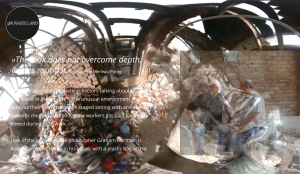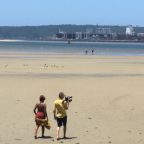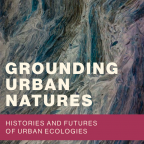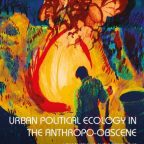
Daniel Fetzner and Graham Harman interview in Garbage City in Cairo.
Visit the installation WASTELAND, in Geneva, February 21–March 11, 2017. With a focus on garbage systems in Cairo and Eschbach in Germany, this artistic research practice by Daniel Fetzner and Martin Dornberg creates sensory experiences in different aesthetic forms and phases about matter and waste. The installation is a topological intersection of art, philosophy and media ecology in the anthropocene.
In a previous post, I wrote briefly how Daniel Fetzner got in contact with me. Here is the information that Daniel sent me about what seems to be a very exciting installation and research project. If you go, please consider writing a post for our Situated Ecologies website about your experience.
*
WASTELAND — The Dispersal of Data, Dust and Matter as a Media Ecological Meshwork
The installation in Geneva starts with an opening concert by Ephraim Wegner on February 21, 6pm
Finissage and Workshop with Daniel Fetzner, Martin Dornberg and Kalevi Kull on March 11, 3pm.
In our workshop we will present and discuss our project with the public. Please visit the website before participating!
There is also the pre-installation in Freiburg. For details, contact Daniel Fetzner.
Freiburg, June 2016
48H WASTELAND
Installation, microbes lab, screenings and concert
The art event 48H WASTELAND in a municipal cinema in Freiburg was transforming environmental data from two different garbage systems in Cairo/Egypt and Eschbach/Germany. On both locations sensors were implemented to transmit data. The wireless parasites streamed discrete numbers of humans, animals and machines, which were sonified in the media ecological meshwork of the exhibition.
Geneva, Feb 21 to March 11, 2017
WASTELAND LIQUIFIED
Installation, concert and workshop
The installation WASTELAND LIQUIFIED will use 360° video and surround sound of the artistic research as an interactive experience. The project is exploring a flow of (im)-material substances in order to establish a media ecological meshwork with the visitor. The object oriented interface with its multitudes of inner scenic relations will be installed and performed as a »flow of material substance in a space that is topologically fluid« (Ingold). What are (the) materials and (the) semiotics in the context of a web based 360° interactive documentary? How does this meshwork emulsify with our liquid thinking? Can this be considered as a »hyperobject« (Morton) or as a »living semioshere« (Uexküll)? What are the consequences for an embedded mode of observation as artistic experience? What transforms objects, concepts, living beings (as parasites and bacteria) into waste or into something useful?
Bâtiment d’Art Contemporain (BAC)
http://www.fmac-geneve.ch


